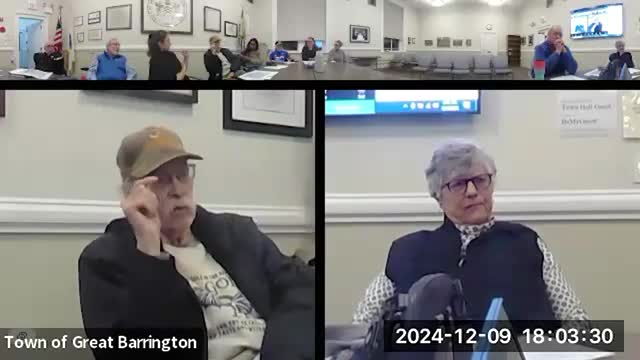Great Barrington debates $160K soccer field amid concerns over taxpayer funding and facility use
December 10, 2024 | Great Barrington, Berkshire County , Massachusetts
This article was created by AI summarizing key points discussed. AI makes mistakes, so for full details and context, please refer to the video of the full meeting. Please report any errors so we can fix them. Report an error »

In the heart of Great Barrington, a recent Parks Commissioners meeting illuminated the ongoing debate surrounding the allocation of taxpayer money, particularly in relation to the Community Preservation Act (CPA) funds. As the commissioners gathered, the conversation quickly turned to the pressing need for a multipurpose field, with some members questioning the necessity of additional facilities like a girls' softball field and a Little League field.
One commissioner candidly expressed skepticism about the demand for a new girls' softball field, suggesting that the current participation levels did not justify the expense. "I don't think there's enough girls playing softball to justify that field," they stated, advocating instead for a comprehensive study of the existing facilities to determine their future use and potential redesign.
The discussion also highlighted the complexities of funding. While CPA money is indeed taxpayer money, it is supplemented by state matching funds, which can range from 25% to 55%. This means that every dollar spent could potentially yield additional financial support from the state, making the decision to invest in community projects even more critical. "The $800,000 CPA money is money that's gonna be spent on something," one commissioner noted, emphasizing the importance of making informed choices about its use.
Concerns about the management and security of the proposed field were also raised. Commissioners expressed apprehension about the potential for misuse of the facilities, urging for a solid management plan to ensure the space is respected and maintained. "If we're gonna put that amount of money into it, we better have a plan," one member insisted, underscoring the need for responsible stewardship of community resources.
As the meeting progressed, the commissioners acknowledged the significant contributions from the state to the CPA fund, which have totaled between $3 to $4 million over the years. This financial backdrop adds another layer of responsibility to their decision-making process, as they strive to balance community needs with fiscal prudence.
In conclusion, the Great Barrington Parks Commissioners are at a crossroads, weighing the benefits of new recreational facilities against the realities of community engagement and financial sustainability. As they move forward, the decisions made in these meetings will shape the landscape of local parks and recreational opportunities for years to come.
One commissioner candidly expressed skepticism about the demand for a new girls' softball field, suggesting that the current participation levels did not justify the expense. "I don't think there's enough girls playing softball to justify that field," they stated, advocating instead for a comprehensive study of the existing facilities to determine their future use and potential redesign.
The discussion also highlighted the complexities of funding. While CPA money is indeed taxpayer money, it is supplemented by state matching funds, which can range from 25% to 55%. This means that every dollar spent could potentially yield additional financial support from the state, making the decision to invest in community projects even more critical. "The $800,000 CPA money is money that's gonna be spent on something," one commissioner noted, emphasizing the importance of making informed choices about its use.
Concerns about the management and security of the proposed field were also raised. Commissioners expressed apprehension about the potential for misuse of the facilities, urging for a solid management plan to ensure the space is respected and maintained. "If we're gonna put that amount of money into it, we better have a plan," one member insisted, underscoring the need for responsible stewardship of community resources.
As the meeting progressed, the commissioners acknowledged the significant contributions from the state to the CPA fund, which have totaled between $3 to $4 million over the years. This financial backdrop adds another layer of responsibility to their decision-making process, as they strive to balance community needs with fiscal prudence.
In conclusion, the Great Barrington Parks Commissioners are at a crossroads, weighing the benefits of new recreational facilities against the realities of community engagement and financial sustainability. As they move forward, the decisions made in these meetings will shape the landscape of local parks and recreational opportunities for years to come.
View full meeting
This article is based on a recent meeting—watch the full video and explore the complete transcript for deeper insights into the discussion.
View full meeting
